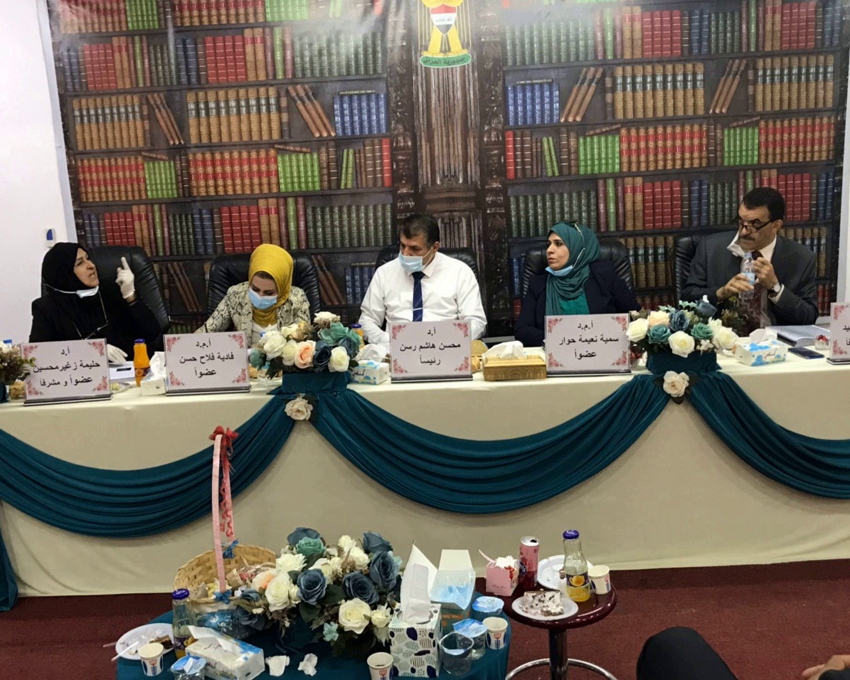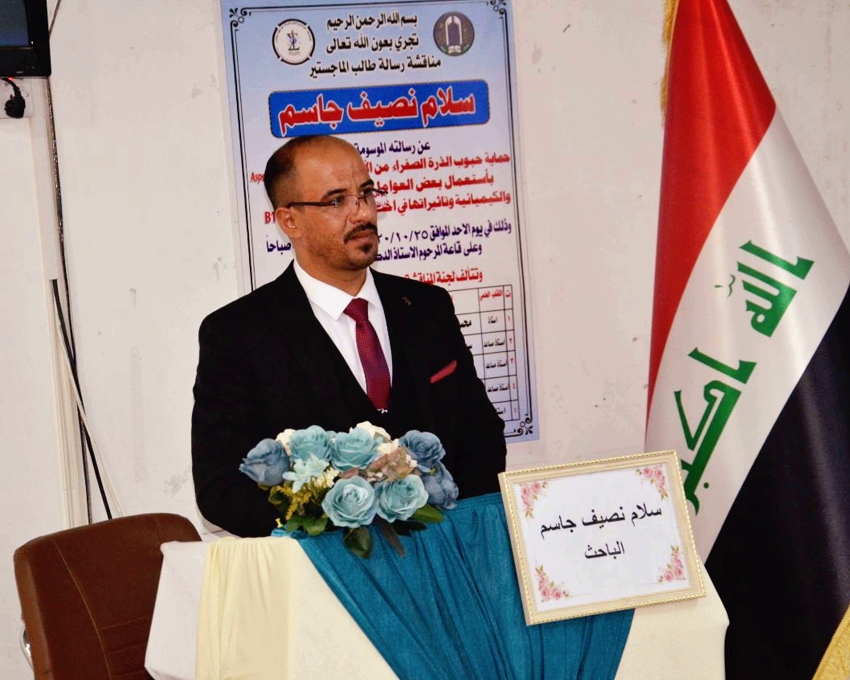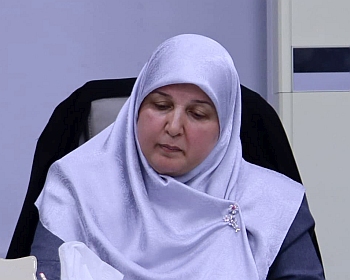ناقش قسم علوم الحياة في كلية التربية للعلوم الصرفة ( ابن الهيثم) رسالة الماجستير الموسومة ( دراسة تأثير بعض العوامل الاحيائية والنانوية والكيميائية في اختزال سم الافلاتوكسين B1 وحماية حبوب الذرة الصفراء من الاصابة بالفطر Aspergillus flavus ) للطالب ( سلام نصيف جاسم محمد ) التي انجزها تحت اشراف التدريسي في القسم ( أ.م.د ثامر عبد الشهيد محسن ) و لتدريسية في كلية الزراعة ( أ.د حليمة زغير حسين ) ونوقشت من قبل أعضاء لجنة المناقشة المبينة أسمائهم فيما يأتي :
-
ا.د. محسن هاشم رسن (رئيساً)
-
ا.م.د. سمية نعمة خوار (عضوا)
-
ا.م.د. فادية فلاح حسن (عضوا)
-
ا.م.د. ثامر عبد الشهيد محسن (عضوا ومشرفاً)
-
ا.د. حليمة زغير حسين (عضوا ومشرفاً)

ويهدف البحث الى :
-
تشخيص الفطر flavus المنتِج لسم AFB1 جزيئيا.
-
استعمال مواد أمنة وصديقة للبيئة للسيطرة على الفطريات ونواتجها السامة مختبريا واختبار كفاءتها مثل مسحوق الفطر lucidum والسائل اللبني لنبات الديباج Calotropis porcera (Latex) في تثبيط نمو الفطر A.flavus ومنع انتاج سم AFB1 واختزاله على حبوب الذرة الصفراء المخزونة.
-
مقارنة كفاءة المعاملات المستعملة مع مستحضر الفايلكس وأوكسيد المغنيسيوم النانوي في تثبيط الفطر flavus واختزال AFB1 .
اظهرت نتائج العزل والتشخيص مرافقة الاجناس الفطرية Aspergillus ، Fusarium ، Penicillium و Rhizopus لحبوب الذرة الصفراء. تصدر الفطر A.flavus الانواع بنسبة 52.87% ، اذ كان تسلسل الفطريات المعزولة بالترتيب A.flavus ، Penicillium ، A.niger ، Fusarium ، Rhizopus و Aspergillus spp. وبالنسب 52.87 ، 15.92 ، 11.78 ، 10.19 ، 6.69 و 2.55 % على التوالي.
كما اوضحت نتائج الكشف عن AFB1 باستعمال صفائح الكروماتوكرافي الرقيقة TLC عن قابلية عزلات A.flavus على انتاج سم AFB1 في الوسط السائل وبتراكيز مختلفة. بينت نتائج تقدير سم الـ AFB1 بوساطة جهاز الكروماتوغرافيا السائل ذو الأداء العالي High Performance Liquid Chromatography (HPLC) للعزلة الاكثر تألقا على صفيحة الكروماتوكرافي الطبقة الرقيقة Thin-Layer Chromatography (TLC) مقدرة عالية على انتاج السم في الوسط السائل اذ بلغ 22.6 جزء بالبليون/25 مل . اظهر التشخيص الجزيئي لعزلة A.flavus الاكثر انتاجا للسم نسبة تطابق 97% مع عزلات A.flavus المنتجة للسم في بنك المعلومات الجيني ، اذ تم ايداع التتابع النيوكليوتيدي في بنك الجينات العالمي تحت رمز بنكي (MN960162).
اوضحت نتائج اختبار المعاملات في تثبيط عزلة الفطر A.flavus تفوقاً معنوياً (P<0.05) لمعاملتي الفايلكس Phylex و اوكسيد المغنيسيوم النانوي Nano Magnesium Oxide (MgO NPs) ، اذ بلغت نسب تثبيط الفطر على وسط البطاطا والدكستروز Potato dextrose Agar (PDA) لمادة الفايلكس 71 Phylex ، 85 ، 100 و 100% للتراكيز 0.1 ، 0.15 ، 0.2 و 0.3 % على الترتيب. اما معاملة اوكسيد المغنيسيوم النانوي MgONPs فقد سببت تثبيطاً بنسب 81.66 ، 89.33 ، 98 و 100 % للتراكيز 0.5 ، 1 ، 1.5 و 2 % بالتتابع. واظهرت النتائج وجود فروق معنوية بين معاملتي مسحوق الفطر Ganoderma lucidum والسائل اللبني لنبات الديباج Calotropis procera (latex) بالمقارنة مع معاملة السيطرة . ثبط مسحوق الفطر G.lucidum نمو الفطر A.flavus على وسط PDA بنسبة 54.4 ، 51.66 ، 46.33 ، 39.11 و 18.22% للتراكيز 2.5 ، 5 ، 10 ، 250 ، 1000 ملغم على الترتيب. اما السائل اللبني لنبات الديباج C. procera (latex) فقد اعطى نسب تثبيط 53.33 ، 57.77 ، 59 و 64.88 % عند التراكيز 0.1 ، 0.2 ، 0.3 و 0.5 % على التوالي. ولتقييم فاعلية المعاملات في اختزال سم AFB1 مختبرياً ، فقد تم اختبار افضل التراكيز من تجربة تثبيط A.flavus على وسط PDA في اختزال سم AFB1 على الوسط السائل لمستخلص الخميرة والسكروز Yeast extract sucrose broth medium (YES) ، اذ افادت النتائج ان المعاملات : الفايلكس 0.2مل ، MgO NPs 1.5غم ، مسحوق الفطر G.lucidum 5 ملغم والسائل اللبني لنبات الديباج C.procera (latex) 0.5 مل قد اعطت نسب اختزال بلغت 92.13 ، 63.42 ، 27.63 و 74.28% على التوالي.
اظهرت نتائج التجربة الخزنية لتثبيط نمو الفطر A.flavus وتثبيط انتاجه للـ Aflatoxin B1 (AFB1) على حبوب الذرة الصفراء نسب تثبيط بلغت 93.3 ، 61.0 ، 52.9 و 74.9% لمعاملات الفايلكس(تركيز 0.2 مل) ، MgO NPs (تركيز 1.5 غم) ، مسحوق الفطر G.lucidum (تركيز5ملغم) والسائل اللبني لنبات الديباج C.procera (latex) (تركيز0.5 مل) على التوالي. بينما بينت نتائج اختزال AFB1 على حبوب الذرة الصفراء تحت ظروف التخزين، تفوقاً معنوياً لمعاملات الفايلكس Phylex (تركيز 0.2 مل) ، مسحوق الفطر G.lucidum (تركيز1000 ملغم) والسائل اللبني لنبات الديباج C. procera (latex) (تركيز 0.5 مل) على المعاملات الاخرى ، اذ بلغت نسب الاختزال 91.38 ، 88.64 و 77.85% على التوالي . في حين لم تظهر معاملتي MgONPs (تركيز1.5 غم) ، مسحوق الفطر G.lucidum (تركيز5 ملغم) فروق معنوية فيما بينهما ، اذ بلغت نسب الاختزال 35.73 و 22.17% على الترتيب.
حققت معاملة الفايلكس Phylex (تركيز0.2 مل) زيادة في محتوى الذرة الصفراء للبروتين بنسبة 2.8%، وخفض الكاربوهيدرات بنسبة 0.022% . اما معاملة MgONPs (تركيز 1.5غم ) فلم تؤثر في نسبة البروتين ، ولكنها رفعت من نسبة الكاربوهيدرات ، فقد بلغت النسب 2.1 و 0.029% على الترتيب. في حين ان معاملة مسحوق الفطر G.lucidum (تركيز 5 ملغم) قد خفضت البروتين بنسبة 1.4% ، وزادت من الكربوهيدرات بنسبة 0.025% بالقياس الى معاملة المقارنة 2.1 و 0.024% على التوالي. في حين ان اضافة C. procera (latex) (تركيز0.5 مل) قد خفضت نسبة البروتين الى 1.8% ورفعت نسبة الكاربوهيدرات بنسبة 0.026%.
وخلص الطالب الى التوصيات الاتية :
-
معاملة حبوب الذرة الصفراء المخزونة بمستحضر الفايلكس لمنع تلوثها بفطر flavus وسم AFB1 .
-
امكانية رش الجسيمات النانوية لاوكسيد المغنيسيوم في حبوب الذرة الصفراء لحمايتها من التلوث بالفطر flavus .
-
استعمال مسحوق الفطر Lucidum في تعفير حبوب الذرة الصفراء سواء كانت معدة للاستهلاك البشري او الحيواني ، لقدرتها على تثبيط فطر A.flavus واختزال سم AFB1 .
-
دراسة تأثير مسحوق الفطر Lucidum في تثبيط فطريات اخرى.
-
القيام بدراسات موسعة لدراسة كفاءة الاختزال لمسحوق الفطر Lucidum تجاه سموم فطرية اخرى.
-
اجراء دراسات حول قدرة السائل اللبني لنبات الديباج في تثبيط فطريات اخرى واختزال السموم .










